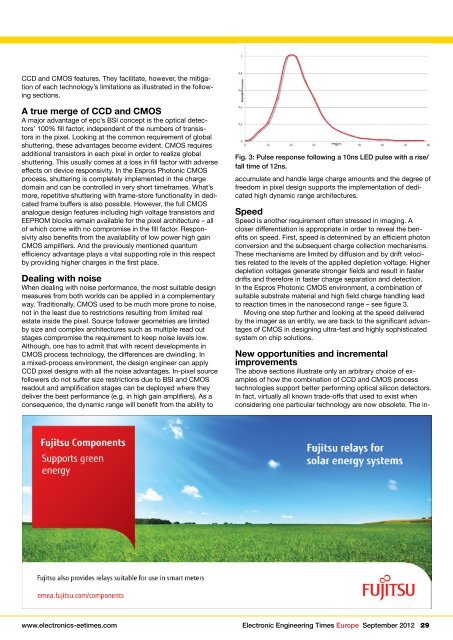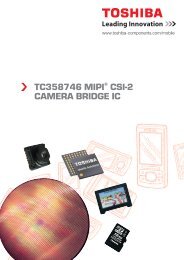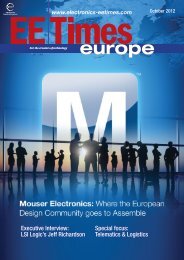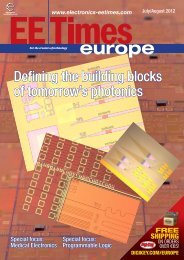Energy harvesting: a thin film approach - EE Times Europe
Energy harvesting: a thin film approach - EE Times Europe
Energy harvesting: a thin film approach - EE Times Europe
Create successful ePaper yourself
Turn your PDF publications into a flip-book with our unique Google optimized e-Paper software.
CCD and CMOS features. They facilitate, however, the mitigation<br />
of each technology’s limitations as illustrated in the following<br />
sections.<br />
A true merge of CCD and CMOS<br />
A major advantage of epc’s BSI concept is the optical detectors’<br />
100% fill factor, independent of the numbers of transistors<br />
in the pixel. Looking at the common requirement of global<br />
shuttering, these advantages become evident. CMOS requires<br />
additional transistors in each pixel in order to realize global<br />
shuttering. This usually comes at a loss in fill factor with adverse<br />
effects on device responsivity. In the Espros Photonic CMOS<br />
process, shuttering is completely implemented in the charge<br />
domain and can be controlled in very short timeframes. What’s<br />
more, repetitive shuttering with frame-store functionality in dedicated<br />
frame buffers is also possible. However, the full CMOS<br />
analogue design features including high voltage transistors and<br />
<strong>EE</strong>PROM blocks remain available for the pixel architecture – all<br />
of which come with no compromise in the fill factor. Responsivity<br />
also benefits from the availability of low power high gain<br />
CMOS amplifiers. And the previously mentioned quantum<br />
efficiency advantage plays a vital supporting role in this respect<br />
by providing higher charges in the first place.<br />
Dealing with noise<br />
When dealing with noise performance, the most suitable design<br />
measures from both worlds can be applied in a complementary<br />
way. Traditionally, CMOS used to be much more prone to noise,<br />
not in the least due to restrictions resulting from limited real<br />
estate inside the pixel. Source follower geometries are limited<br />
by size and complex architectures such as multiple read out<br />
stages compromise the requirement to keep noise levels low.<br />
Although, one has to admit that with recent developments in<br />
CMOS process technology, the differences are dwindling. In<br />
a mixed-process environment, the design engineer can apply<br />
CCD pixel designs with all the noise advantages. In-pixel source<br />
followers do not suffer size restrictions due to BSI and CMOS<br />
readout and amplification stages can be deployed where they<br />
deliver the best performance (e.g. in high gain amplifiers). As a<br />
consequence, the dynamic range will benefit from the ability to<br />
Fig. 3: Pulse response following a 10ns LED pulse with a rise/<br />
fall time of 12ns.<br />
accumulate and handle large charge amounts and the degree of<br />
freedom in pixel design supports the implementation of dedicated<br />
high dynamic range architectures.<br />
Speed<br />
Speed is another requirement often stressed in imaging. A<br />
closer differentiation is appropriate in order to reveal the benefits<br />
on speed. First, speed is determined by an efficient photon<br />
conversion and the subsequent charge collection mechanisms.<br />
These mechanisms are limited by diffusion and by drift velocities<br />
related to the levels of the applied depletion voltage. Higher<br />
depletion voltages generate stronger fields and result in faster<br />
drifts and therefore in faster charge separation and detection.<br />
In the Espros Photonic CMOS environment, a combination of<br />
suitable substrate material and high field charge handling lead<br />
to reaction times in the nanosecond range – see figure 3.<br />
Moving one step further and looking at the speed delivered<br />
by the imager as an entity, we are back to the significant advantages<br />
of CMOS in designing ultra-fast and highly sophisticated<br />
system on chip solutions.<br />
New opportunities and incremental<br />
improvements<br />
The above sections illustrate only an arbitrary choice of examples<br />
of how the combination of CCD and CMOS process<br />
technologies support better performing optical silicon detectors.<br />
In fact, virtually all known trade-offs that used to exist when<br />
considering one particular technology are now obsolete. The in-<br />
www.electronics-eetimes.com Electronic Engineering <strong>Times</strong> <strong>Europe</strong> September 2012 29












